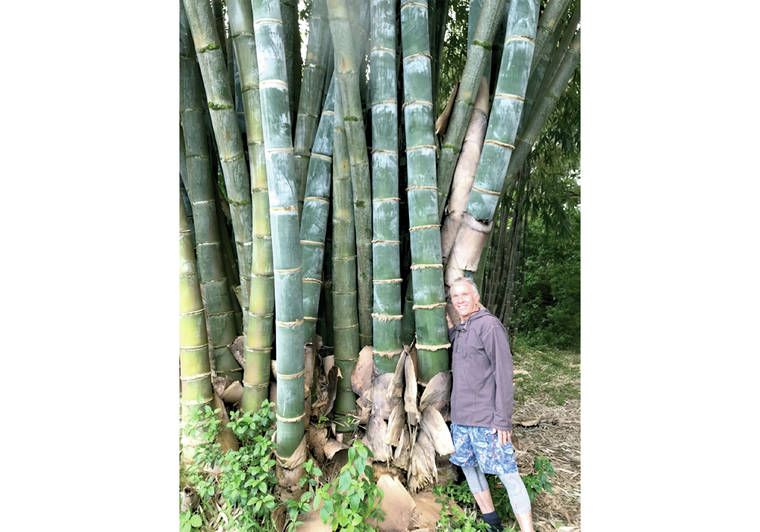Tropical Gardening: Bamboo survive after Agent Orange in Vietnam

The bamboo family is amazing, with more than 1,200 species, mostly from Asia.
The bamboo family is amazing, with more than 1,200 species, mostly from Asia.
The first plant to appear after the bombing of Hiroshima and Nagasaki in Japan was bamboo. After spraying the forests of Vietnam with Agent Orange, bamboos and grasses were the first to recover, as broad-leaved trees withered and died thus changing the ecosystems for decades to come.
ADVERTISING
We are heading to Vietnam and Myanmar next week to observe the recovery of the forests, farming and people of the areas that were once devastated by war. This will be the subject of the next several articles as we traverse the region.
Bamboo can teach us about the process of healing in the world. There is something magical about bamboo in the garden, as well.
Most folks who enter a forest of bamboo are immediately aware of some kind of spiritual awakening and a feeling of peace. Even in a crowded city such as Tokyo around this time of year bamboo is used to focus on our spiritual natures by using the kadomatsu. We see this tradition also here in Hawaii.
The kadomatsu is an important component of celebrating Oshogatsu, or the Japanese New Year. It is a traditional decoration placed in pairs in front of homes to welcome ancestral spirits, or kami. You usually see them from Christmas through the first week of the new year, and they are thought to temporarily house the kami that bring good fortune and abundant crops for the family.
About mid-January, the kodomatsu are burned to appease the kami and release them.
Styles vary, but generally are composed of three shoots of different heights to represent heaven, human and earth. They are bound with straw rope. The two kadomatsu represent male and female.
This is just one example of the importance of bamboo. You can see bamboo used in spiritual ways such as this also in Bali, Thailand, Vietnam, Myanmar or Cambodia.
Bamboo is used in many styles of flower arrangements and garden design because of the intrinsic spiritual qualities. In tropical and warm temperate Asia, bamboo is used from the cradle to the grave and referred to as “the brother of man”
According to the Hawaii Chapter of the American Bamboo Society, to remove the barriers to a sustainable approach using locally grown bamboo materials in building, we first need to develop appropriate building codes. Second, we need to train our builders in bamboo craft and third, we have top-quality bamboo building materials.
Local farmers already grow the new commercial species suited for construction. These are strong and insect- and disease-resistant, unlike our common ornamental and fishing pole types. Several builders, craftsmen and artists are already becoming adept at using bamboo, but presently are using culms imported from Asia.
With proven data on engineering properties, mechanical processes and construction technologies, we need to give planning and building departments the technical specifications to meet code requirements.
Hawaii architects, contractors and professionals in the building trades will soon have the knowledge to use bamboo in innovative and creative ways, not only to build homes but furnish them as well.
Bamboo furniture is taking the place of the long popular rattan. Many folks confuse rattan palm with bamboo. Rattan is a vining palm that grows in the rain forests of the tropics. It is becoming scarce as the forests are cleared.
Rattan is much slower growing, and because of its spiny nature, not likely to be planted commercially. Bamboo, on the other hand, lends itself to agricultural management and does not require rain forest destruction to use it. Some fine bamboo furniture is now being imported from Bali and the Philippines.
Our old sugar cane lands are ideally suited to growing bamboo, and a healthy mixture of forest crops including bamboo would be environmentally and aesthetically sound. However, even with a little patch of land, you can grow enough bamboo to supply building material for a family.
Leadership for opening the way to a local bamboo industry comes from the American Bamboo Society, Hawaii County and island farmers.
Given that bamboo grows at an incredible rate and has strength likened to that of steel, it seems to be an obvious resource just begging to be explored. Interest in bamboo as a building material is growing as rapidly as bamboo itself.
What remains to be seen by the skeptic, as well as the enthusiast, is how models of bamboo construction might be transferred to developed countries. Design professionals and officials would like to see something they can relate to with their rational minds.
Work on establishing international standards for construction grade bamboo is the single most important step in raising the status of bamboo from ornament, food and craft to a bona fide Hawaii building material.
We are fortunate that one of the main growers and suppliers of more than a hundred species of bamboo is located on our island. You can contact Peter Berg and Susan Ruskin of Quindembo Bamboo Nursery in North Kohala at 987-6452 for information and bamboo species to suit your location.


